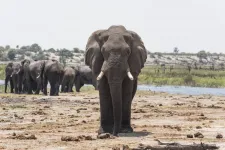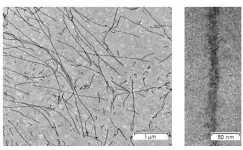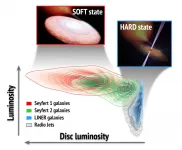INFORMATION:
The study received funding from the Leverhulme Trust.
The paper, published in the journal Animal Behaviour, is entitled: "Field evidence supporting monitoring of chemical information on pathways by male African elephants."
Scent trails could boost elephant conservation
2021-05-26
(Press-News.org) Travelling elephants pay close attention to scent trails of dung and urine left by other elephants, new research shows.
Scientists monitored well-used pathways and found that wild African savannah elephants - especially those travelling alone - were "highly attentive", sniffing and tracking the trail with their trunks.
This suggests these scents act as a "public information resource", according to researchers from the University of Exeter and Elephants for Africa.
More research is now needed to find out whether humans can create artificial elephant trails to divert elephants away from farms and villages, where conflict with humans can cause devastation to communities.
Alternatively, scent trails could be placed to improve the efficiency of routes connecting elephant populations between protected areas.
"Our findings suggest an important role of an elephant's sense of smell in long-distance navigation," said lead author Connie Allen, of Exeter's Centre for Research in Animal Behaviour.
"As elephants follow these trails, they deposit their own urine and dung, which reinforces the pathway's presence for future elephants.
"We see great potential for these findings to be applied to elephant management and conservation - primarily as a method for manipulating elephant movements.
"We carried out this study in Botswana, where the main threat to elephants is conflict with humans.
"By removing the existing scent paths that lead elephants to close contact with humans in problem areas, and redirecting them, perhaps we could reduce such conflicts happening."
The proposed technique could also aid efforts in Botswana to reconnect elephants with populations across southern Africa.
The study, which examined a predominantly male population, also found that urine deposits from adult elephants were more likely to attract attention than that of younger (subadult) males.
"African elephants may therefore be able to discern the age and maturity of individuals they can expect to encounter from remote urine cues on pathways," Allen explained.
ELSE PRESS RELEASES FROM THIS DATE:
Glioblastoma study discovers protective role of metabolic enzyme, revealing a novel therapeutic target
2021-05-26
HOUSTON - Researchers at The University of Texas MD Anderson Cancer Center have discovered a novel function for the metabolic enzyme medium-chain acyl-CoA dehydrogenase (MCAD) in glioblastoma (GBM). MCAD prevents toxic lipid buildup, in addition to its normal role in energy production, so targeting MCAD causes irreversible damage and cell death specifically in cancer cells.
The study was published today in Cancer Discovery, a journal of the American Association for Cancer Research. Preclinical findings reveal an important new understanding of metabolism in GBM and support the development of MCAD inhibitors as a novel treatment strategy. The researchers currently are working to develop targeted therapies against the enzyme.
"With ...
Scientists find a way to detect the spectral signals of amyloid fibrils
2021-05-26
Alzheimer's disease is the most common neurodegenerative disorder in which neurons gradually die off, leading to dementia. The exact mechanism and causes of this disorder have not yet been identified. However, it is known that amyloid plaques form in the brains of patients. Plaques consist of amyloid fibrils, which are special filamentous assemblies formed by amyloid proteins.
'The number of patients with neurodegenerative disorders will continue to grow in the future. Thanks to the success of humanity in the treatment of cancer and cardiovascular diseases, more and more people are living into their 80s. At this age, the risk of developing neurodegenerative disorders, including Alzheimer's disease, becomes very high. Unfortunately, no cures for these diseases have yet ...
Dive bombing killer flies are so fast they lose steering control
2021-05-26
Killer flies can reach accelerations of over 3g when aerial diving to catch their prey - but at such high speeds they often miss because they can't correct their course.
These are the findings of a study by researchers at the Universities of Cambridge, Lincoln, and Minnesota, published today in the Journal of the Royal Society Interface.
Killer flies (Coenosia attenuata) perform high-speed aerial dives to attack prey flying beneath them, reaching impressive accelerations of up to 36 m/s2, equivalent to 3.6 times the acceleration due to gravity (or 3.6g). This happens because they beat their wings as they fall, combining the acceleration of powered flight with the acceleration of gravity.
This is an impressive feat: diving Falcons, the fastest animals that predate ...
Similar states of activity identified in supermassive and stellar mass black holes
2021-05-26
The researchers Juan A. Fernández-Ontiveros, of the Istituto Nazionale di Astrofisica (INAF) in Rome and Teo Muñoz-Darias, of the Instituto de Astrofísica de Canarias (IAC), have written an article in which they describe the different states of activity of a large sample of supermassive black holes in the centres of galaxies. They have classified them using the behaviour of their closest "relations", the stellar mass black holes in X-ray binaries. The article has just been published in the journal Monthly Notices of the Royal Astronomical Society (MNRAS).
Black holes range in mass from objects which have only a few ...
Large amounts of mercury released under southwest Greenland ice sheet
2021-05-26
Mercury pollution is an issue of global concern due to its toxic effects. High levels have already been measured in Arctic organisms - with worrying effects on ecosystems and the food chain. So far, the Greenland Ice Sheet has not been taken into account as a part of the Arctic mercury cycle. Now, researchers led by Jon Hawkings of the German Research Centre for Geosciences in Potsdam and Florida State University show that meltwaters in the southwest of Greenland transport considerable amounts of mercury into the Arctic Ocean. Due to the large quantities detected, the researchers assume that they are of geological origin. They present their measurements in the current issue of Nature Geoscience.
Mercury: poison for humans and the environment - ...
Researchers examine record-shattering 2020 trans-Atlantic dust storm
2021-05-26
LAWRENCE -- For two weeks in June 2020, a massive dust plume from Saharan Africa crept westward across the Atlantic, blanketing the Caribbean and Gulf Coast states in the U.S. The dust storm was so strong, it earned the nickname "Godzilla."
Now, researchers from the University of Kansas have published a new study in the Bulletin of the American Meteorological Society parsing the mechanism that transported the dust. Their results explain a phenomenon that could occur more frequently in the years ahead due to climate change, affecting human health and transportation systems.
African dust darkened the skies of the Caribbean and American Gulf States thanks to a trio of atmospheric patterns, ...
Proteomics reveals how exercise increases the efficiency of muscle energy production
2021-05-26
Mitochondria are the cell's power plants and produce the majority of a cell's energy needs through an electrochemical process called electron transport chain coupled to another process known as oxidative phosphorylation. A number of different proteins in mitochondria facilitate these processes, but it's not fully understood how these proteins are arranged inside mitochondria and the factors that can influence their arrangement.
Now, scientists at the University of Copenhagen have used state-of-the-art proteomics technology to shine new light on how mitochondrial proteins gather into electron transport chain complexes, and further into so-called supercomplexes. The research, which is published in Cell Reports, also examined ...
Slender robotic finger senses buried items
2021-05-26
Over the years, robots have gotten quite good at identifying objects -- as long as they're out in the open.
Discerning buried items in granular material like sand is a taller order. To do that, a robot would need fingers that were slender enough to penetrate the sand, mobile enough to wriggle free when sand grains jam, and sensitive enough to feel the detailed shape of the buried object.
MIT researchers have now designed a sharp-tipped robot finger equipped with tactile sensing to meet the challenge of identifying buried objects. In experiments, the aptly named ...
Slope stability model can help prevent landslides to protect communities and save lives
2021-05-26
A mathematical model which can predict landslides that occur unexpectantly has been developed by two University of Melbourne scientists, with colleagues from GroundProbe-Orica and the University of Florence.
Professors Antoinette Tordesillas and Robin Batterham led the work over five years to develop and test the model SSSAFE (Spatiotemporal Slope Stability Analytics for Failure Estimation), which analyses slope stability over time to predict where and when a landslide or avalanche is likely to occur.
In a study published in Scientific Reports, the research team was ...
LHAASO detect dozen sources of ultra-high energy gamma-rays
2021-05-26
Discovered by Victor Hess in 1912, cosmic rays, relativisitic particles that shower Earth, contribute a signicant part of the energy density in the universe and carries unambiguous informations on various astrophysical processes . Yet until now, origin of cosmic rays is still a mystery.
A key problem in understanding the origin of cosmic rays is the searching for the acceleration site up to or even beyond Ultra-high energy (UHE). Such extreme accelerators are dubbed as PeVatrons. However, composed of subatomic particles, such as protons or atomic nuclei, cosmic rays are charged and lose ...







